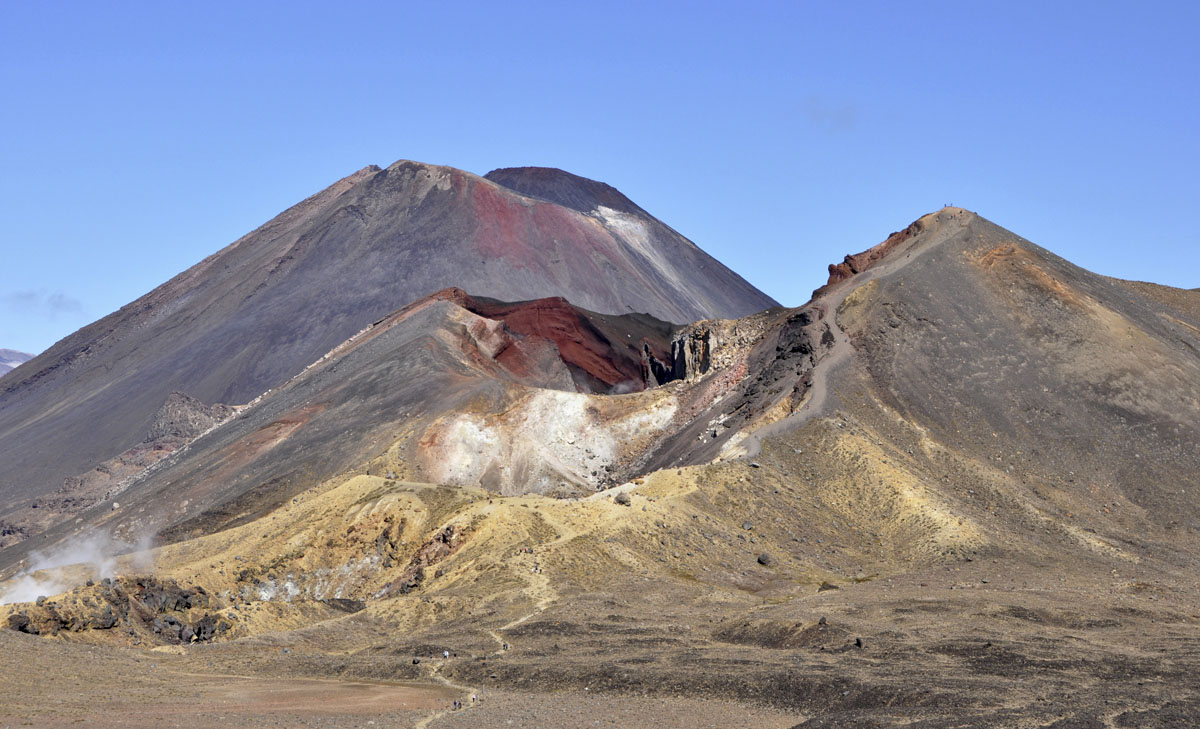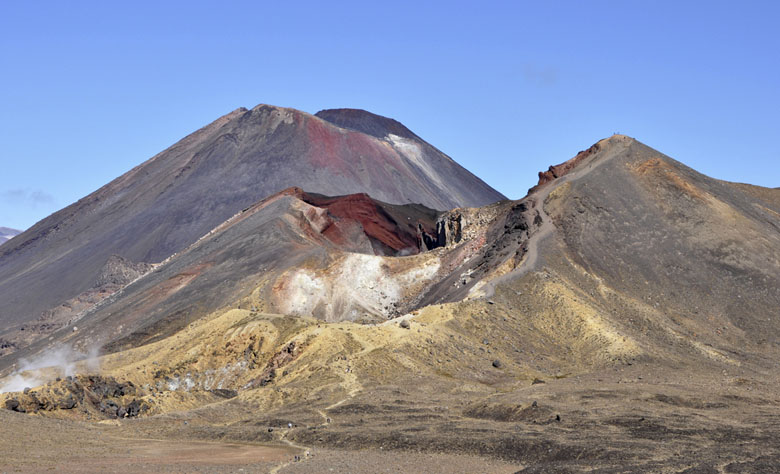

David Wilkinson


David Wilkinson
Tongariro National Park on the North Island is a place far removed from the lush rainforests of the South Island, yet this volcanic wonderland is among New Zealand’s most striking landscapes. Established in 1887 as the first national park in the country and only the fourth in the world, the three mighty volcanoes Tongariro, Ngauruhoe, and Ruapehu are big, readily accessible, and active. In fact, the famed trail of the Tongariro Alpine Crossing allows you to walk amidst the lava fields, turquoise volcanic lakes, and even up the cones themselves.
The Tongariro Crossing, the most popular excursion in the park, is a strenuous 19-kilometer day hike over the ridge between Mt. Tongariro and the perfectly shaped Mt. Ngauruhoe. Crowds are to be expected but the Crossing is worth it—views are spectacular throughout and the volcanic experience is tough to rival. The windy high point of the trail perched between the two peaks offers wide-ranging vistas of the surrounding UNESCO World Heritage area (it enjoys dual status both for its natural and cultural importance to the Maori people). In a way, this ridge feels like the center of New Zealand.
Craggy Mt. Ruapehu appears to be the ugly brother of Mt. Ngauruhoe but one could argue that the real majesty of the park lies with the former. Mt. Ruapehu is the largest active volcano in New Zealand and the highest point on the North Island. The closer one gets to the mountain the clearer it becomes that this volcano is much more complex and functions as a world onto itself. Deep valleys and plateaus adorn its many faces, and the range of ecosystems includes mountain beech forest, desert, tussock, and glacial river valleys.
Passing high between the volcanoes Tongariro and Ngauruhoe, the Tongariro Crossing is often called New Zealand's best day hike.
Length: 19.4 km
Time: 5–8 hours
Difficulty: Moderate to Challenging
The Tongariro Alpine Crossing is the premier day hike in New Zealand. Located in a dual status UNESCO World Heritage area, the trail passes closely among old lava flows, steaming vents, a giant red crater, and turquoise volcanic lakes. The perfectly shaped cone of Mount Ngauruhoe, a centerpiece of the hike, famously starred as Mount Doom in Peter Jackson’s Lord of the Rings trilogy.
On the whole, the Tongariro Alpine Crossing lives up to its reputation. There just aren't many places in the world where you can walk intimately among volcanoes of this stature (the only contender I know of would be Maui's Haleakala National Park). And although the Department of Conservation makes clear that the Crossing and the conditions in the park are not to be taken lightly, those who are reasonably fit and/or determined shouldn't have any problems completing the hike. Below is a hike summary:
Mangatepopo Car Park to Soda Springs (1–1½ hours)
The hike begins in the flat grasslands in the Mangatepopo Valley surrounded by black lava flows. The darkest flows are the newest—the lava has yet to break down and the strong reflection of the sun inhibits the growth of lichens and mosses. As the trail slowly approaches the base of the volcanoes Tongariro and Ngauruhoe, Soda Springs, an oasis of sorts in the stark landscape, is a quick 15-minute side trip off the left side of the trail.
Soda Springs to the South Crater (1–1½ hours)
The steep ascent from the valley floor up to the South Crater is the most difficult section of the Tongariro Crossing. Rising from an elevation of 900 meters to 1,600 meters in a short distance, the portion of the track is challenging but well groomed with plenty of places to rest. The views from high on the the South Crater are fantastic—along with the National Park’s three volcanoes, Mount Taranaki often is visible to the west.
South Crater to Emerald Lakes (1–1½ hours)
Past the South Crater is the final short and steep incline to the Red Crater, which marks the hike's peak elevation at 1,886 meters. The bright tint of the crater and the strong sulfur smell it emits bring to life how active these volcanoes truly are. Fifteen minutes down the trail from the Red Crater are the popular Emerald Lakes, whose azure color, caused by the leaching of minerals from nearby thermal areas, stands out dramatically against the reddish hillside.
Emerald Lakes to Ketatahi Hut (1–1½ hours)
One of the highlights of the trek is walking through the vast expanse of the Central Crater ("crater" actually is a misnomer as the area is believed to be a glacial basin) with Tongariro and Ngauruhoe looming in the distance.
Ketatahi Hut to Ketatahi Car Park (1½–2 hours)
It feels like the Ketatahi Hut must be close to the finish line, but there is still a significant stretch of easy walking ahead. The trail passes down through tussock grasslands into a forested area, ending with a long flat section to the Ketatahi Car Park where transportation awaits.
Ngauruhoe Summit (3 hours round trip)
From the South Crater is a challenging climb to the summit of Ngauruhoe (2,287 m). The trail is not officially marked and almost all craggy scree, but enough people do the route on a daily basis that it’s relatively straightforward to follow. If you arrive at the South Crater early enough and are up for a tough scramble, the vista at the top is superb.
Tongariro Summit (2 hours round trip)
From the Red Crater a poled footpath leads to the summit of Tongariro, an easier alternative to the Ngauruhoe Summit hike with excellent views back toward Ngauruhoe.
The Tongariro Crossing is walked in one direction starting from the Mangatepopo car park and ending at the Ketatahi car park. Limited spaces are available for individual cars (the area is considered a high risk for break-ins), but given the ending point and layout of the roads it makes the most sense to utilize one of the Tongariro Crossing’s many shuttle providers. They will drop you conveniently at the trailhead with a range of pick-up times at the end for a smooth return trip. Depending on your pace, the full track takes 5–8 hours to complete, without side hikes.
1. Arrive as Early as Possible
The Tongariro Crossing is world-renowned and by midmorning the trail is crowded. Avoid the masses by arranging for the earliest possible transportation to the trailhead (Discovery has you there by 6 am).
2. Prepare for a Steep Climb
The trail gains over 1,000 meters in elevation during the first half of the hike. There are ample places to stop and rest and you will notice many people doing exactly that. Pace yourself, drink plenty of water, and you shouldn’t have problems completing the hike.
3. Keep an Eye on the Weather
On a typical day it will be warm at the bottom and windy and cold at the top. Check the weather reports before you head out and be aware that the conditions change quickly. Bring a day pack with warm clothes, rain gear, and plenty of water and snacks.
For those interested in overnight hiking trips in Tongariro National Park, the Tongariro Northern Circuit is one of New Zealand’s Great Walks. However, the most scenic section of the trek is the Tongariro Crossing itself, which easily is completed as a day hike. Do the Crossing, but the best multi-day option in the park and one of New Zealand’s great hidden gems is the Round the Mountain Track circumventing neighboring Mt. Ruapehu.
It seems counterintuitive to walk in a circle for 4–5 days around a single mountain, but what emerges is a deeper understanding of the volcanoes that make the region famous. You will see Mt. Ruapehu from all angles, through numerous sunrises and sunsets, and walk every footstep of its base. Some sections of the trail meander away from the volcano while others cut high across its flanks. The brief journey through the lahar—or debris flow—is not for the faint of heart but gets as up close with the geological activity as one can get. Remember to move quickly.
At the end of the journey and at the foot of Mt. Ruapehu is the luxuriant Chateau Tongariro, styled after the Canadian Resort of Lake Louise. It doesn’t feel like a hotel of Georgian nature should be situated within the ruggedness of the national park, but there is something timeless about the structure that evokes an era when access was far more limited. A small handful of places around the world attracted the high-fliers to experience exotic and wild country and return home to tell their friends, and the Chateau Tongariro was near the top of the list. You don’t have to stay at the hotel, but it’s hard to top the plush couches and dramatic floor-to-ceiling windows in the lobby that stare directly at the faces of the famous volcanoes. Certainly there are worse places to enjoy a well-earned beer after a few days in the backcountry.